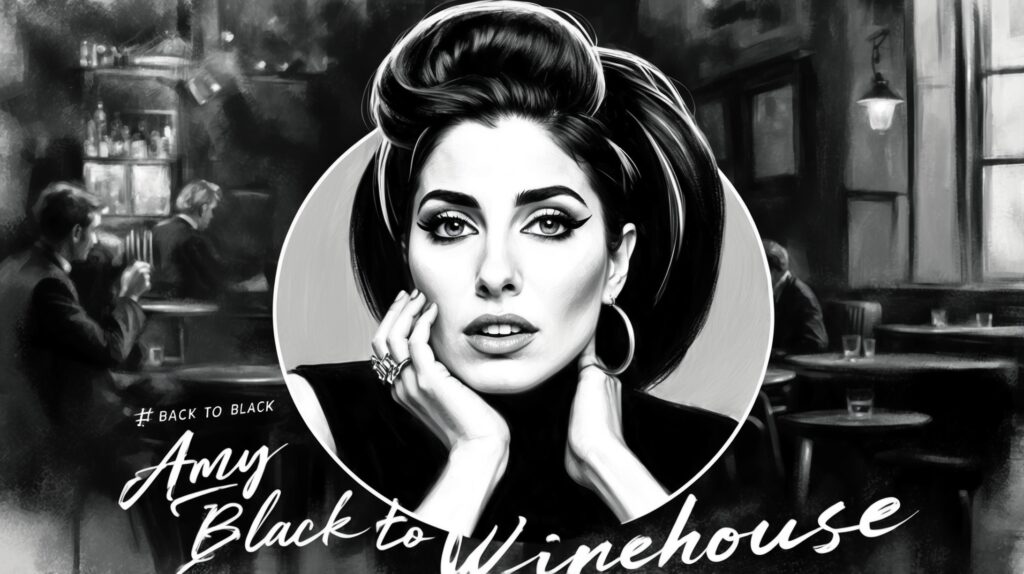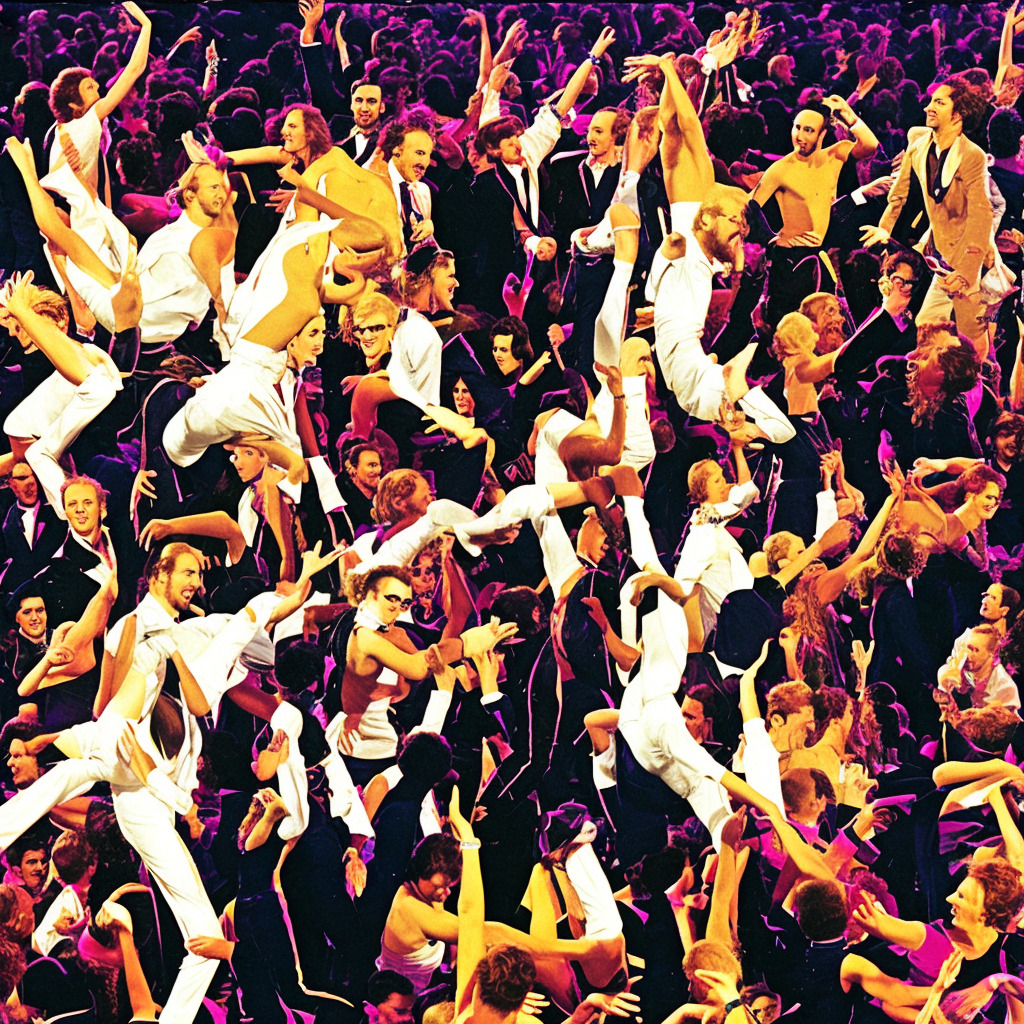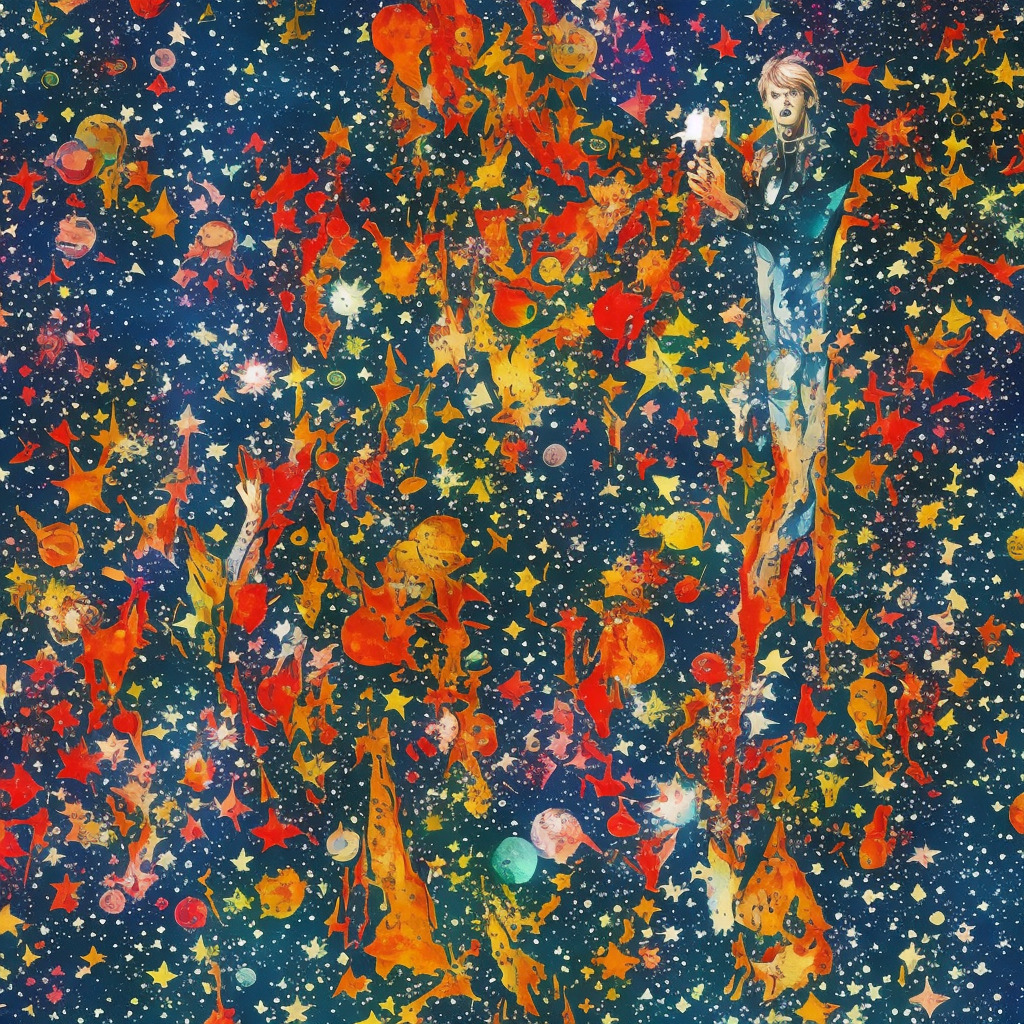Amy Winehouse: A Soulful Journey
Amy Winehouse was a musical force who redefined contemporary music with her soulful voice and poignant lyrics. Her journey into music began young, and with her second album, “Back to Black,” she became a global phenomenon. In collaboration with producers like Mark Ronson, Winehouse’s unique style and emotional depth left a lasting legacy in the music world.

Amy Winehouse was more than just a singer and songwriter; she was a musical phenomenon whose profound impact on the music industry is still felt today. Known for her deep, expressive contralto vocals and her eclectic mix of musical genres, Amy’s artistry shone through most prominently in her second studio album, “Back to Black”. Released in 2006, the album and its title track marked a turning point in Winehouse’s career, solidifying her status as one of the most influential artists of her generation.
Born in Southgate, London, in 1983, Amy Winehouse possessed an early affinity for music, inspired by jazz greats such as Frank Sinatra and Sarah Vaughan. Her journey in the music industry began when she was discovered by a talent scout while still in her teens. This led to the release of her debut album, “Frank”, in 2003, which received critical acclaim and showcased her potential as a leading figure in contemporary music. But it was with “Back to Black” that Winehouse truly left an indelible mark, resonating with listeners worldwide.
The period around the release of “Back to Black” was pivotal in Winehouse’s career. During this era, she collaborated with celebrated producers like Mark Ronson, whose partnership was instrumental in crafting the iconic sound of the album. Winehouse’s personal life, often tumultuous and scrutinized by the public and media, infused the album with raw emotional depth. The song itself, “Back to Black,” reflects on themes of heartbreak and loss, allowing listeners to glimpse into Amy’s soul. Despite her struggles, Winehouse’s music and distinctive style captivated audiences, earning her widespread admiration and establishing a legacy that continues to inspire artists today.
The Craftsmanship of Mark Ronson
Explore the genius behind “Back To Black” as we delve into the creative prowess of composer Mark Ronson. Discover his background, musical style, and crucial role in crafting the song’s iconic sound.

Background and Career: Mark Ronson is a pivotal figure in the music industry, celebrated for his versatility as a producer, DJ, and composer. Born in 1975 in London, he was immersed in music from an early age, partly due to his family’s connections to the industry. After studying at New York University, Ronson embraced the burgeoning New York club scene as a DJ, which laid the groundwork for his distinctive style. His career breakthrough came with the production of Amy Winehouse’s “Back to Black” album, which solidified his status as a formidable musical force.
Musical Style and Influences: Ronson is known for his rich fusion of genres, drawing from funk, soul, hip-hop, and pop, often blending vintage sounds with modern production techniques. Influenced by classic artists like Stevie Wonder and Prince, Ronson’s works often possess a nostalgic yet contemporary feel. His ability to seamlessly integrate various musical elements has earned him both commercial success and critical acclaim.
Collaborations and Partnerships: Ronson’s collaborative spirit is a hallmark of his career. He has partnered with an array of artists, including Bruno Mars, Lady Gaga, and Lily Allen, showcasing his adaptability and keen ear for talent. However, his collaboration with Amy Winehouse is perhaps the most iconic, as it not only highlighted his ability to elevate an artist’s sound but also set new standards in the industry with its timeless quality.
Role in the Song’s Creation: In “Back To Black,” Ronson’s contribution as a composer was instrumental in defining the album’s signature sound. His meticulous production synthesized Winehouse’s raw vocal intensity with a lush, 1960s-inspired arrangement. Ronson’s compositional techniques, such as employing orchestral strings and horns blended with modern beats, created a melancholic yet powerful backdrop that matched the emotional depth of Winehouse’s lyrics, ensuring the song’s memorability and enduring appeal.
Impact on the Song’s Success: Ronson’s work on “Back To Black” was central to the album’s phenomenal impact, as the song’s success owes much to its polished yet emotive musical arrangement. His composition was integral to the album’s critical and commercial triumph, making it a benchmark for blending contemporary music with retro influences. Critics lauded his ability to craft an authentic sound that resonated across diverse audiences.
Legacy and Influence: Ronson’s work on “Back To Black” has left an indelible mark on the music industry. The album’s success helped redefine modern soul music, and Ronson’s contributions are viewed as key catalysts in this evolution. His penchant for innovation continues to inspire both established and emerging artists, affirming his stature as a transformative figure in the contemporary music landscape.
Celebrating the Impact of ‘Back to Black’
Explore the song’s journey through awards, covers by other artists like Beyoncé, and its appearances in films and more.
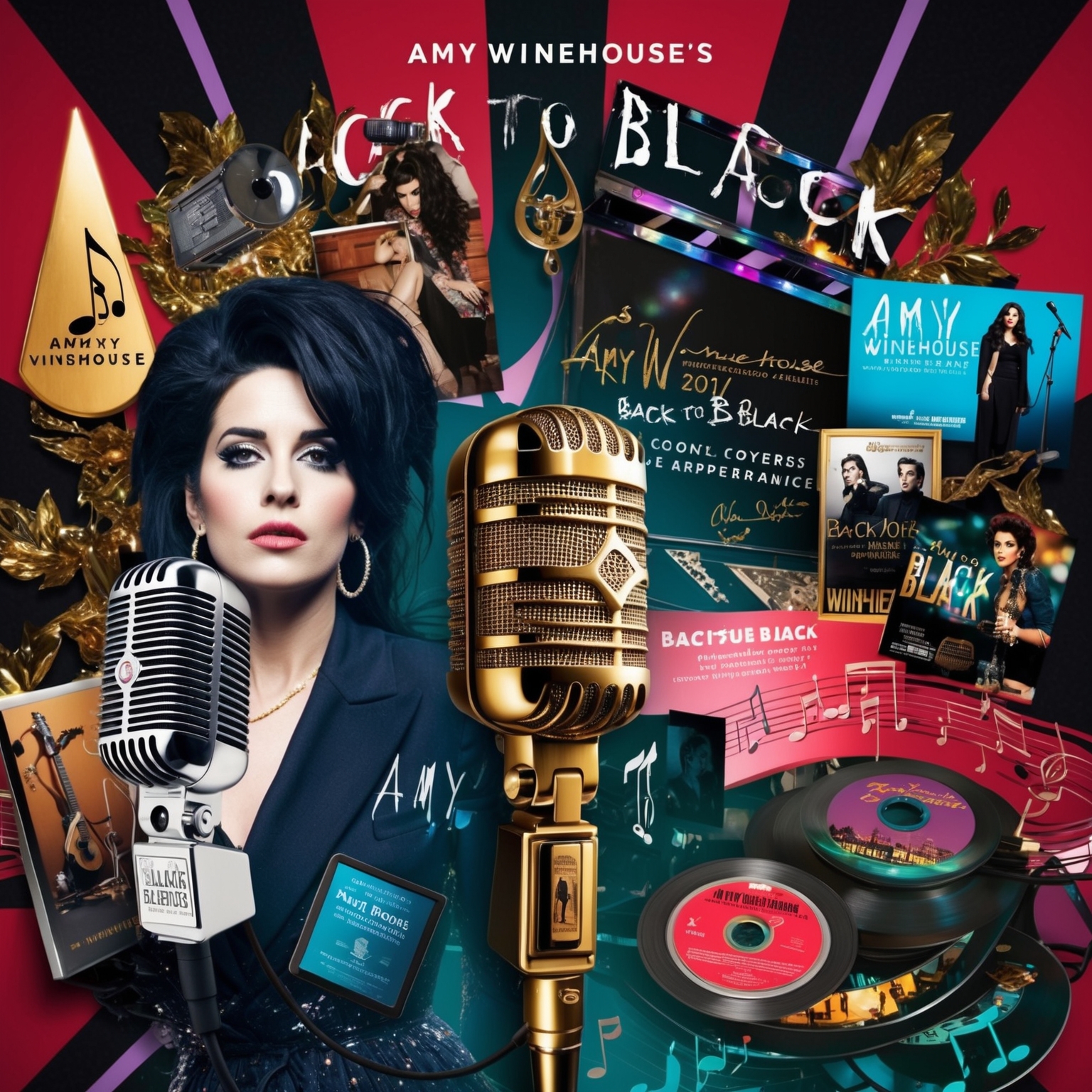
Back to Black is not just another track in Amy Winehouse’s discography; it’s a song that has garnered significant recognition in the music industry. Over time, it has won both accolades and a special place in the hearts of its listeners. While the track itself did not win a Grammy, the album of the same name won the Grammy Award for Best Pop Vocal Album in 2008. The song’s raw and emotional authenticity was acknowledged globally, earning Amy Winehouse immense respect and admiration.
The legacy of ‘Back to Black’ expands well beyond awards, as the song has been covered by several notable artists, each adding their own unique flavor while honoring the original. One of the most well-known covers is by Beyoncé and André 3000, which appeared in the soundtrack for the 2013 Baz Luhrmann film, The Great Gatsby. This version brought the song into a new cinematic light, resonating with a different audience and showing its timeless appeal.
Moreover, ‘Back to Black’ found its way into various films, TV shows, and even video games, further solidifying its status as an iconic track. It was featured in the soundtrack of the 2007 film St. Trinian’s, introducing the song to an even wider audience. The song’s presence in popular culture highlights the powerful impact of Amy Winehouse as an artist who transcended beyond just music to influencing art forms across the board.
Rising Through the Ranks: Chart Success of ‘Back To Black’
Rising through the ranks, ‘Back To Black’ cemented Amy Winehouse’s status as a music icon. With chart success in Europe, the UK, and beyond, it fueled her career while leaving a lasting cultural legacy.
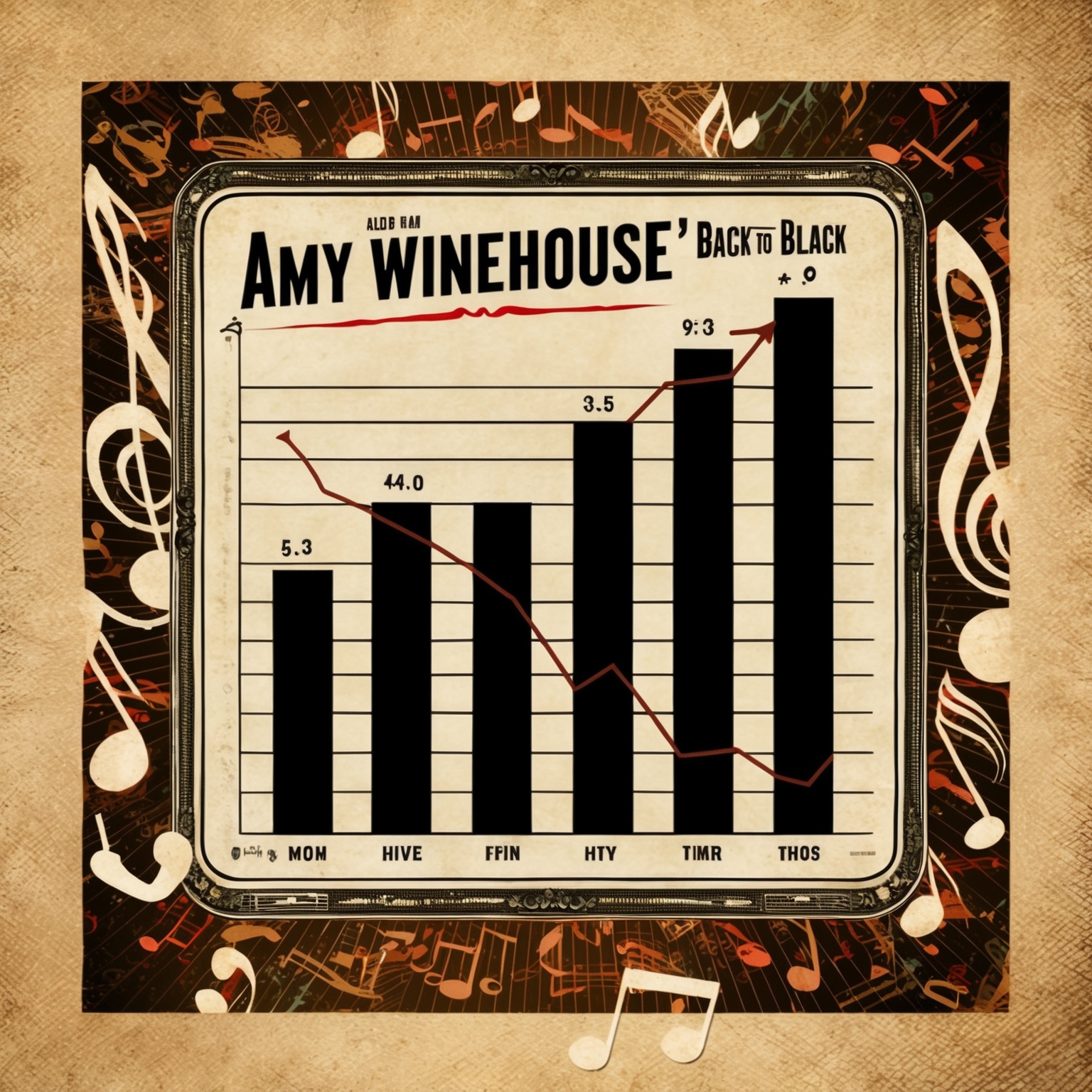
Back To Black by Amy Winehouse was released on April 30, 2007, as the title track of her second studio album. Initially, the song debuted at modest chart positions around the world; however, it quickly began to climb due to its raw emotion and captivating lyrical content. In the UK Singles Chart, it peaked at number 25, a respectable position that showcased Winehouse’s growing influence in the music scene. Internationally, the song reached the top 10 in various European countries and found strong footholds in the US, Canada, and Australia.
In comparison to other tracks on the album, including the iconic ‘Rehab’, ‘Back To Black’ reinforced Amy Winehouse’s established presence in music while contributing to her status as a breakthrough artist in the soul and jazz resurgence of the 2000s. Following the success of Back To Black, Winehouse experienced a meteoric rise in her career, further solidifying her as a staple in contemporary music. This song, with its unique blend of retro soul and modern sensibilities, played a significant role in shaping Winehouse’s career trajectory and influencing future artists.
The rejuvenation of the soul genre, coupled with targeted marketing efforts and the release of a captivating music video, significantly boosted the song’s popularity. From public performances to features in films and television, Back To Black received extensive media coverage that amplified its reach. Its critical acclaim and strong public reception laid the groundwork for its enduring legacy, turning it into an anthem of its time with lasting cultural impact.
Visual Brilliance: The ‘Back To Black’ Music Video
The ‘Back to Black’ music video, directed by Phil Griffin, is a visual masterpiece that brings to life the song’s themes of love and loss. Its black-and-white aesthetic, narrative style, and critical acclaim have significantly boosted the song’s global popularity.
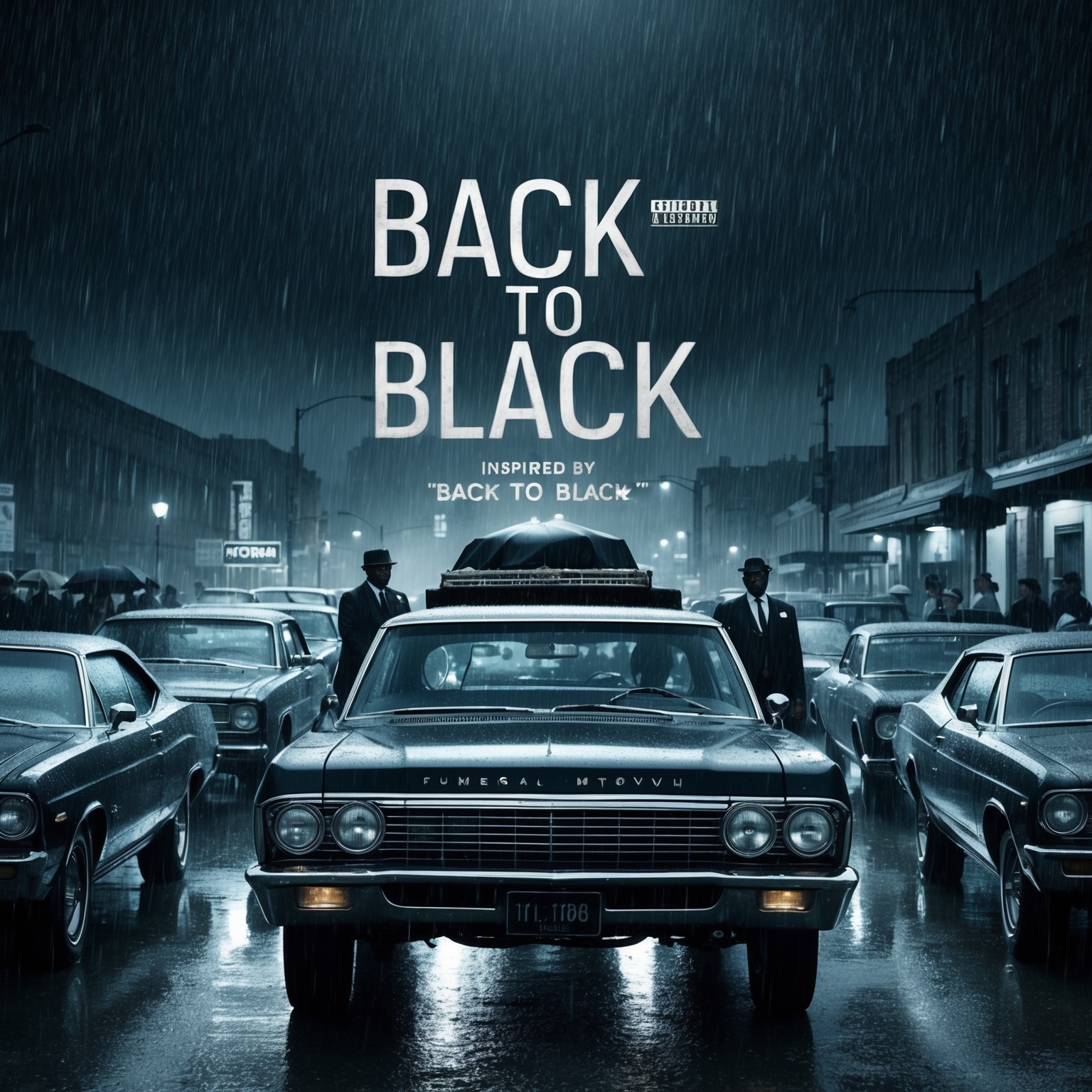
Amy Winehouse’s ‘Back to Black’ is not only an aural masterpiece but also a visual triumph, thanks to its evocative music video. Directed by Phil Griffin, the video immerses viewers in a world that mirrors the song’s hauntingly melancholic themes. Shot in black-and-white, the video beautifully blends elements of 1960s Motown aesthetics with a modern, somber twist, reflecting the song’s exploration of heartbreak and nostalgia. The choice of monochrome not only underscores the song’s themes of mourning and loss but also pays homage to the soul and jazz influences that define Winehouse’s sound.
One of the most striking aspects of the music video is its narrative style, which closely follows the themes of love and loss expressed in the lyrics. It vividly portrays a funeral procession, symbolizing the end of a turbulent relationship. Winehouse’s presence is both central and enigmatic, as she navigates through the scenes with a poignant, almost stoic demeanor. The video’s ambiance, filled with vintage cars and melancholic rain settings, enhances the overall emotional depth, making it a perfect visual companion to the track.
The music video was well-received, contributing significantly to the song’s global popularity. Critics lauded it for its artistic execution and its ability to visually capture the raw emotion encapsulated in the song. Phil Griffin’s direction was praised for its creative boldness, leaving a lasting impact on viewers and cementing Winehouse’s iconic status. The music video not only amplified the song’s reach but also exemplified the synergy between visual arts and music, making it a classic standalone piece in its own right.
Navigating the Complex Layers of ‘Back To Black’
Explore the intricate song structure of Amy Winehouse’s ‘Back To Black’, a masterful blend of melody, harmony, and rhythm, set in the key of D minor. Dive into its unique instrumentation and thematic evolution within her discography.
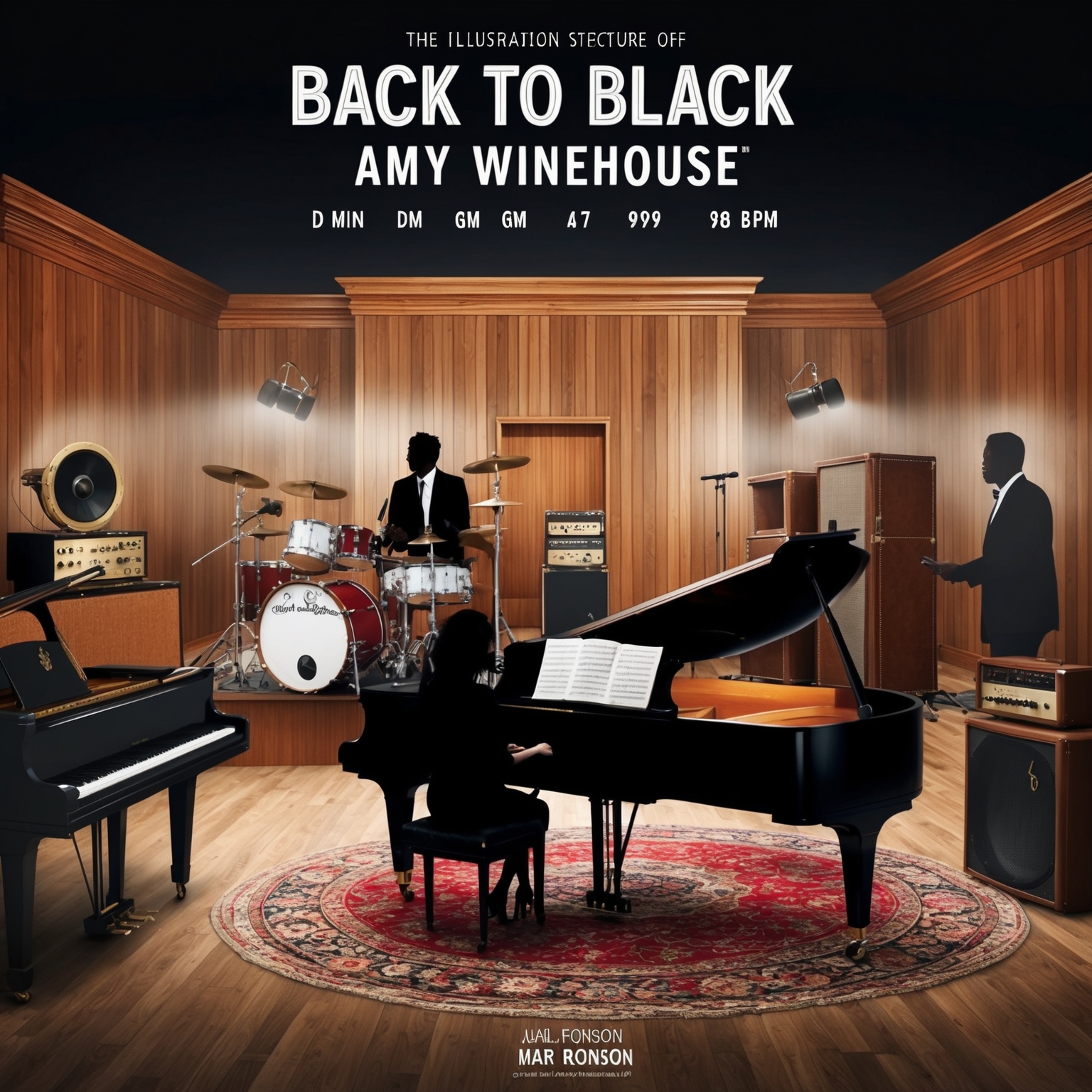
‘Back To Black’ by Amy Winehouse showcases a sophisticated and deeply emotive song structure, reflecting the profound themes of heartache and introspection. Written in the key of D minor, the song leverages a classic chord structure Dm, Gm, and A7, which enhances its melancholic feel while offering a poignant auditory narrative. The tempo, moderately slow at approximately 98 BPM (beats per minute), facilitates a somber and reflective mood, allowing listeners to dwell in the emotional landscape painted by Winehouse’s vocal delivery.
The melody of ‘Back To Black’ is both haunting and alluring, featuring Winehouse’s soulful vocal phrases layered seamlessly over a rich harmonic backdrop. The harmony is intentionally simple yet powerful, providing enough space for the emotional intensity of the lyrics to shine through. The rhythm, characterized by a steady groove, underscores the narrative while subtly accenting the weight of the lyrical content.
Instrumentation plays a crucial role in crafting the unique sound of ‘Back To Black’. The track predominantly features traditional instruments like piano, bass, and drums, accompanied by string arrangements that add depth and texture. The production techniques echo the Motown era, helmed by music producer Mark Ronson, who employed a vintage approach to capture the essence of Winehouse’s artistry.
In the context of Winehouse’s discography, ‘Back To Black’ signifies a pivotal evolution in her musical journey. It departs from the jazzy undertones of her debut album, ‘Frank’, and embraces a more mature, soulful, and retrospective theme. This track, along with its album companions, marks Amy Winehouse’s deeper exploration of soul and R&B genres, illustrating her growth as an artist and her resonance with timeless musical themes.
Delving into the Heartache: Analyzing the Poignant Lyrics of ‘Back to Black’
An insightful exploration of Amy Winehouse’s ‘Back to Black’ lyrics, unraveling themes of heartbreak, emotional vulnerability, and the haunting metaphor of returning to darkness.
Kept his dick wet
With his same old safe bet
Me and my head high
And my tears dry
Get on without my guy
You went back to what you knew
So far removed from all that we went through
And I tread a troubled track
My odds are stacked, I’ll go back to black
We only said goodbye with words
I died a hundred times
You go back to her, and I go back to
I go back to us
I love you much
It’s not enough
You love blow, and I love puff
And life is like a pipe
And I’m a tiny penny rolling up the walls inside
We only said goodbye with words
I died a hundred times
You go back to her, and I go back to
I go back to black
Black, black, black, black
Black, black, black
I go back to
I go back to
We only said goodbye with words
I died a hundred times
You go back to her, and I go back to
We only said goodbye with words
I died a hundred times
You go back to her, and I go back to black
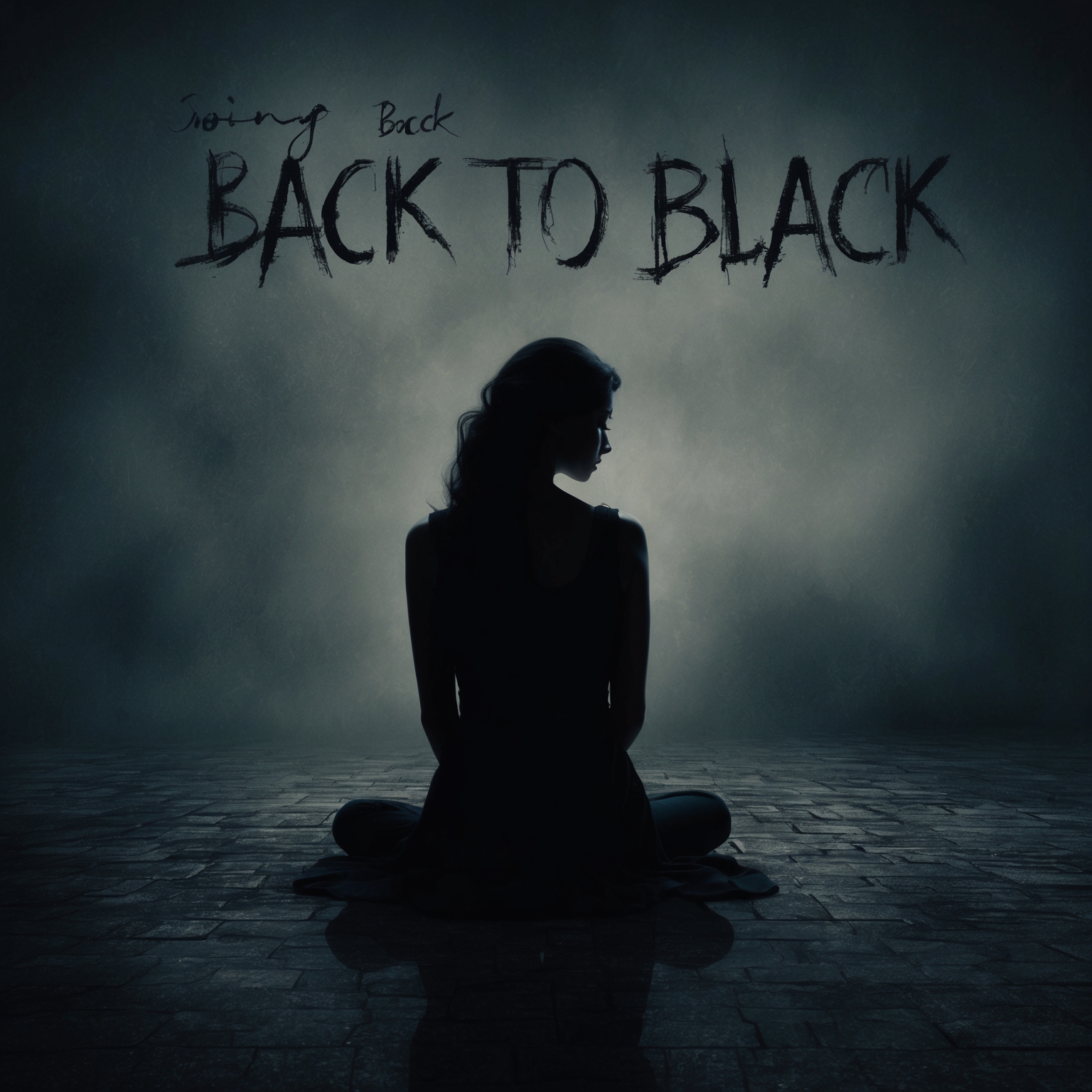 Amy Winehouse’s ‘Back to Black’ offers a vivid tapestry of emotion, capturing the turmoil of heartbreak and addiction with its raw and evocative lyrics. At the core, the song explores themes of loss and despair, tracing the painful aftermath of a breakup. The lyrics are intensely personal, drawing from Winehouse’s own life experiences, yet they resonate universally, reflecting the timeless agony of unreciprocated love.
Amy Winehouse’s ‘Back to Black’ offers a vivid tapestry of emotion, capturing the turmoil of heartbreak and addiction with its raw and evocative lyrics. At the core, the song explores themes of loss and despair, tracing the painful aftermath of a breakup. The lyrics are intensely personal, drawing from Winehouse’s own life experiences, yet they resonate universally, reflecting the timeless agony of unreciprocated love.
The narrative in ‘Back to Black’ employs a first-person perspective, enhancing its confessional tone. Winehouse begins the song with the palpable sting of betrayal: ‘He left no time to regret, kept his dick wet, with his same old safe bet.’ The blunt honesty immediately sets the emotional tenor; there is no sugarcoating of the hurt or the reality of the relationship’s end. This directness helps listeners connect deeply to her story, recognizing the fragility and complexity of human emotions.
The use of literary devices throughout the lyrics further enriches the song’s emotional impact. Metaphors like ‘life is like a pipe’ and ‘a tiny penny rolling up the walls inside’ evoke a sense of entrapment and instability, highlighting Winehouse’s internal struggle. The recurring motif of ‘going back to black’ symbolizes a return to darkness or depression, a poignant depiction of the cycle of heartbreak. This repetition not only underscores the song’s central theme but also mirrors the relentless, unending nature of personal anguish.
In comparative analysis, ‘Back to Black’ stands unique within Winehouse’s discography for its stark, poetic melancholy. While other tracks may touch on similar themes of love and loss, few do so with the same level of intimate, haunting lyricism. This candid vulnerability has cemented the song’s status as a powerful anthem for those grappling with similar emotional battles. Moreover, cultural and social references, such as the allusion to addiction highlighted in the lyrics, offer a broader commentary on the grips of substance abuse. This layer of depth gives ‘Back to Black’ a lasting relevance, resonating with diverse audiences globally.
The emotional impact of ‘Back to Black’s’ lyrics is immense, offering listeners a poignant reflection on the complexities of love and the subsequent descent into darkness. The heartache and regret that Winehouse captures are palpable, as she bares her soul to the world. This raw honesty continues to evoke profound empathy, allowing many to find solace in shared experiences of loss. Whether interpreted through personal reflections or broader cultural lenses, the lyrics of ‘Back to Black’ leave an indelible mark, inviting introspection and perhaps even healing.
🎶 Did you know Back To Black was inspired by Motown classics? Amy Winehouse channeled her heartbreak into a timeless anthem! 💔🎤 #AmyWinehouse #BackToBlack #SoulVibes tinyurl.com/2jyb4j36
Click to Tweet

